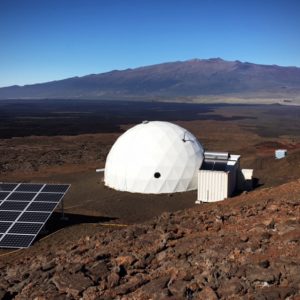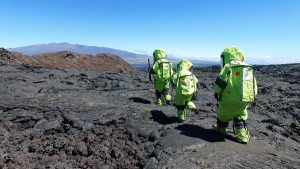By Jennifer Schiller
Did you ever want to go to space? Explore a distant planet and discover its secrets? Yeah, me too. So do the University of Hawai’i at Manoa and NASA, who are simulating life on Mars with the missions of the Hawai’i Space Exploration Analog and Simulation (HI-SEAS). Their goal? Find out how to pick a team capable of living and working together in a small space for a long period of time.
HI-SEAS is a Habitat in an isolated location on the slope of the volcano Mauna Loa on the Big Island of Hawaii, selected for its similarity to Martian geology. Inside the Habitat, crews of up to 6 people spend 4-12 months living and working in 1300 square feet of usable space, with an attached 160 square foot workshop. Everyone has their own bedroom, but each is large enough for a twin size bed and not much else. Privacy is minimal. “Astronauts” eat rehydrated foods and take two-minute showers.

The benefit of going through all this is that they get to explore Mars! Crews go on simulated spacewalks outside in spacesuits, mapping the local area and characterizing various geochemical properties. They’re spelunking in caves and hopping over lava tubes and climbing up cliffs. Also, all the crew members are scientists and have the opportunity to conduct their own studies in this unique environment. For example, Dr. Yajaira Sierra-Sastre of Mission I wanted to reduce the amount of waste created by discarded clothing on long trips. To do this, she researched how long certain kinds of clothes could be worn until her crewmates deemed them “unacceptable.”
While on “Mars,” crew members’ mental health is a priority. Everyone is monitored heavily, both individually and as a group in several ways, so various investigators can study different ways of helping them with stress relief, team dynamics, and group bonding. One study is Mentalblock, which has crew members play cooperative games in Virtual Reality. Their in-game behaviors are linked with psychological and social assessments in an attempt to create a game that can predict which teams will perform well and for a long time.

Other types of research happens, too. Studies on sleep in the Habitat and crew autonomy have been conducted. In Mission III, crew member Zak Wilson focused on 3D printing, designing and printing more than 730 pieces when they needed spare parts (or model rockets). 3D printing what is needed, instead of packing anything that might be needed, can cut down on precious cargo space. Current 3D printing on “Mars” is designed by scientists off-site so as to maximize astronauts’ time.
The most recent mission was Mission VI. A four-member crew was scheduled to be in the Habitat for eight months, from February to October 2018. Unfortunately, after a crew member received an electric shock and was hospitalized, the mission was cancelled. HI-SEAS will be recruiting new “astronauts” for its next mission soon.
If you’re interested in learning more, you can visit the HI-SEAS website to read details about various experiments and hear first-hand accounts of what it’s like to live “in space” for up to a year! Also, the podcast “The Habitat” from Gimlet Media follows the daily lives of the crew members of Hi-SEAS Mission IV.
Edited by Anna Chiarella and Rowan Beck
